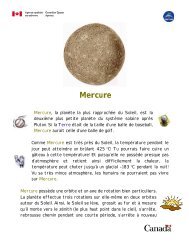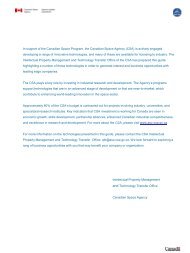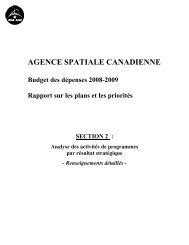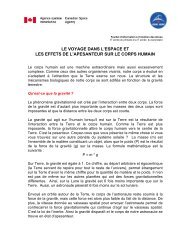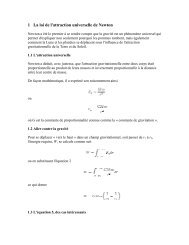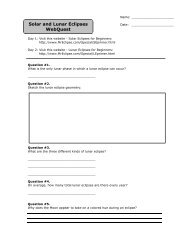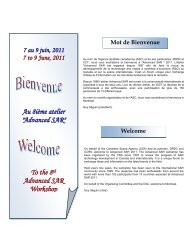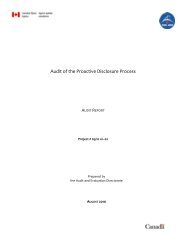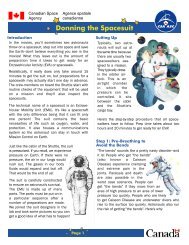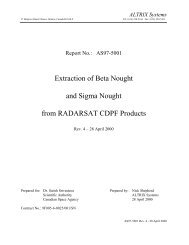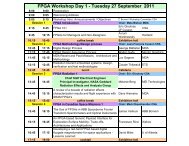PDF version of COSPAR - Space Science Research in Canada Report
PDF version of COSPAR - Space Science Research in Canada Report
PDF version of COSPAR - Space Science Research in Canada Report
You also want an ePaper? Increase the reach of your titles
YUMPU automatically turns print PDFs into web optimized ePapers that Google loves.
These data will be compared with the more detailed ground-basedmeasurements taken before and after the space mission. Hughson will useultrasound to determ<strong>in</strong>e the efficiency <strong>of</strong> the large ve<strong>in</strong> that returns blood to theheart from the lower body. At the same time, he will be monitor<strong>in</strong>g venous bloodpressure through a catheter <strong>in</strong> the right arm.Then he will then use a Lower Body Negative Pressure device to apply suction tothe lower body, which will shift blood out <strong>of</strong> the central region and back down tothe legs. “We can look at changes <strong>in</strong> the volume or size <strong>of</strong> the <strong>in</strong>ferior vena cava,and we can look at the pressure to see how the pressure/volume relationshipchanges.”When someone comes back from space, the ve<strong>in</strong>s are more stretched or “floppy”than they were on Earth. “They hold a greater volume <strong>of</strong> blood at the samepressure,” said Hughson. “They don’t have good muscle tone to hold the bloodnear the heart so when you stand up, the blood could go away from the heart tothe lower part <strong>of</strong> the body. There’s less blood go<strong>in</strong>g up to the bra<strong>in</strong> and you couldfa<strong>in</strong>t.”What happens <strong>in</strong> the gut is also important. “It will hold a lot <strong>of</strong> volume, so youneed a system that very efficiently shuts down the blood flow go<strong>in</strong>g <strong>in</strong>to thatregion,” said Hughson. “We’ll probably see less shutt<strong>in</strong>g down <strong>of</strong> the blood flow<strong>in</strong>to the gut region when you come back from space than you had beforehand.”This would mean it’s “hang<strong>in</strong>g on to too much blood and once aga<strong>in</strong>, there’s lessblood com<strong>in</strong>g back to the heart and therefore a poorer ability to regulate bloodpressure.”Dur<strong>in</strong>g the experiment, Hughson will monitor how much blood the heart ispump<strong>in</strong>g out and how well the blood vessels are constrict<strong>in</strong>g. He wants todeterm<strong>in</strong>e how efficiently reflexes <strong>in</strong> the ve<strong>in</strong>s and arteries are controll<strong>in</strong>g theconstriction. This “vascular resistance” serves as a k<strong>in</strong>d <strong>of</strong> traffic cop, mak<strong>in</strong>gsure blood goes where it’s needed.“If you’re not putt<strong>in</strong>g out as much blood, you need to constrict the blood vesselsso the blood doesn’t go to the wrong place,” Hughson said. “You don’t want itgo<strong>in</strong>g to the gut region or legs; you do want it go<strong>in</strong>g to the bra<strong>in</strong>. If blood pressurestarts to fall, the blood vessels <strong>in</strong> the gut and the legs should constrict and theblood vessels to bra<strong>in</strong> should dilate. We’ll be look<strong>in</strong>g at how efficient the bra<strong>in</strong>blood vessels are at dilat<strong>in</strong>g <strong>in</strong> response to a drop <strong>in</strong> blood pressure.”The number and complexity <strong>of</strong> the systems <strong>in</strong>volved regulat<strong>in</strong>g blood pressuremeans that different k<strong>in</strong>ds <strong>of</strong> countermeasures may be needed to prevent fa<strong>in</strong>t<strong>in</strong>gproblems. One technique already used <strong>in</strong> space, called lower body negative31



